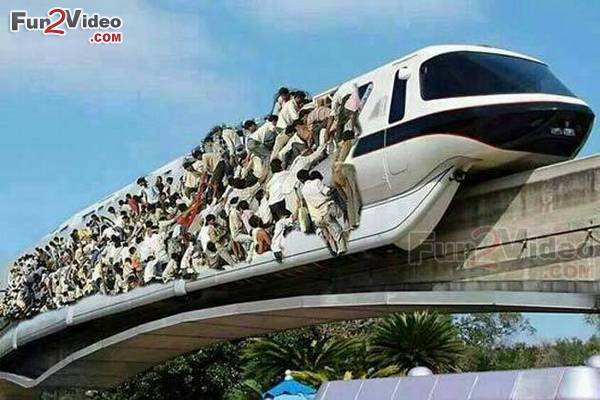Mumbai's monorail cost $450 million. So why is it losing a quarter million a month?

MUMBAI -- When Phase 1 of the Mumbai Monorail launched this February, a meme gained traction on social media. The Photoshopped image depicted one of the clean, futuristic-looking monorail engines used at Walt Disney World's Epcot Center overflowing with Indian railway passengers clinging to its sleek surface for dear life. Mumbaikars immediately got the joke. Due to a high-density population of over 22 million people, Mumbai is a place where political promises and city planning go to die.

Now approaching the fourth month of the monorail's service, the joke appears to be wrong in its prediction of passenger overflow, but correct in the spirit of its satire. Because while the Mumbai Suburban Railway still routinely spills over with passengers, sometimes with fatal consequences, Phase 1 of the Mumbai Monorail seems downright barren by comparison, leading to concerns that it doesn't help one of the world's worst commuting cities enough to justify its costs.
The project was created using India's popular Public Private Partnership model, a system that uses help from private companies to spur large scale public works projects into development. PPPs, as they are often called, are meant to eliminate bureaucratic inefficiencies, but critics claim that they only create new problems.
Running only nine kilometers from the eastern suburb of Chembur to Wadala, the seven-stop, 19-minute journey is losing an average of more than $240,000 dollars per month on operational costs, according to figures released in April by the Mumbai Metropolitan Region Development Authority, the state-based organization that runs the monorail. And recent ridership numbers don't portend a rapid turn around. After an inaugural run of around 20,000 passengers per day in the train's first week, when the monorail ran from 7 a.m. to 3 p.m., April's numbers were closer to 15,000 passengers per day, despite the addition of a more commuter-friendly timetable of 6 a.m. to 8 p.m. As a point of comparison, the Mumbai Suburban Railway can transport as many as eight million people in one day -- a number about the population of New York City.
The problem with attracting travelers is more of a matter of the monorail's utility, rather than the cost of a ticket. The fare from Wadala Road to Chembur, the opposite ends of the track is only 11 rupees per person, or $0.18 USD, a similar price to what you might pay for a second class ticket along the same distance using the Mumbai Suburban Railway. But the stops along the way, like the delightfully named "Fertilizer Township," lack commuters, and are populated more by smokestacks and factories than shops and offices. (When I rode the monorail in mid-April during the start of rush hour, the solid majority of riders were joy-seekers and tourists taking pictures.)
The city's vibrant tabloid culture has been predictably critical of the project's inefficiencies, regularly noting its $450 million construction bill, and the seven years the project took to complete. The Mumbai Monorail was built using a PPP, which combines state planning with assistance from private developers. (In this case,the Denmark-based group Larsen and Tourbo and the Malaysia-based group Scomi Engineering.) The use of a PPP was supposed to facilitate the creation of the monorail, but critics say that it created additional expenses and conflicting priorities. State-run projects here in India don't have the most sterling reputation, but critics say injecting help from foreign elements of the private sector may not be an ideal solution.
"PPPs are meant to makes things more efficient but too often the opposite happens," says Ratoola Kundu, an Assistant Professor at the Tata Institute of Social Science, and a specialist in matters of urban development. "The contracts that are drawn up ultimately favor the private side, leaving the planners frustrated."
P.R.K. Murthy, the Chief of the Mumbai Metropolitan Development Authority, and the public face behind its construction, acknowledges being frustrated by the process of working with foreign companies, saying that "public works would have done enough on their own." But he also claims that people are judging this project far too quickly.
"People in the Indian media are not thinking of the big picture," Murthy said from his office in the Bandra neighborhood of Mumbai. "It's not possible to offset the costs of such a project from just revenue. The long-term purpose is to spur economic growth and when it's all finished, that's what this project will do."
Time will tell if Murthy's predictions are accurate. The Mumbai Monorail's initial 9km offering was intended, after all, to be the first link on a longer, and theoretically more useful ride.
In the coming years, the Mumbai Monorail will expand an additional 11 km, stretching from its current run into Lower Parel, a major working and shopping district in the heart of the city. But if Milind Deora, a sitting Member of Parliament and candidate for reelection from the district of Mumbai South has anything to say about it, the monorail will extend even further -- all the way to the edges of the Arabian Sea.
While on a campaign stop in April, Deora declared that his political dream was to bring the monorail project into Colaba, a popular tourist hub in the city, near Gateway of India and the Taj Hotel. But relative to those lofty ambitions, the train hasn't yet left the station.
Top photo: arzankotval2002/Flickr
Related:
- Diamante Porsches? Lime Lamborghinis? China's crazy customized cars
- Reinventing the rickshaw one city at a time
- Professionals in Delhi turn to image consulting
Sign up for our biweekly newsletter featuring in-depth business innovation stories by correspondents around the globe, top domestic reporters and thought-provoking opinion columnists.
This post was originally published on Smartplanet.com